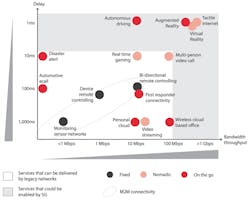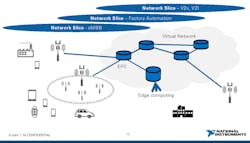Now is an exciting time to be an engineer or technology enthusiast. We’re starting to see ideas that were talked about as only concepts in science fiction making their way to the mainstream. Many of these new flashy technologies, like the self-driving car, will be enabled in some way, shape, or form by 5G.
The epitome of science-fiction technology, though, is artificial intelligence (AI). It’s the robot that will interact with us, or in the case of some horror films, be humanity’s ultimate downfall. While we’re still years away from having a robot like the one on the TV cartoon The Jetsons doing our housework, 5G and AI are helping speed up the pace. Not only do they enable each other, but their fates are somewhat intertwined. 5G provides the infrastructure and massive amounts of data that AI needs to be successful, and AI, driven by advances in machine learning, provides the ability to make sense of the chaos and complexity of 5G.
To be clear, 5G is a set of new technologies, while AI is not. The basic algorithms used by machine learning to create AI have been relatively unchanged for the last 30 years. The concept, called backpropagation, is fairly simple. Data sets and the expected outcomes associated with them are input into a processor, and it outputs a pattern. The more data sets and outputs that are used as inputs to the processor, the more accurate the resulting pattern. Machine learning thrives with massive amounts of data, and 5G will create massive amounts of data.
Latency
One of the defining characteristics of 5G that makes it dramatically different than previous standards is the fact that it has a spec for latency built in (the target is 1 ms). Figure 1 from GSMA Intelligence presents a visual diagram of various applications that rely on cellular networks. The applications in gray are the ones that require some combination of the massive bandwidth and throughput promised by 5G in addition to tight latency requirements.
1. The diagram shows the various applications that rely on cellular networks. (Source: GSMA Intelligence)
While some applications, like augmented reality, will require very deterministic and low latency, others such as streaming video and making a phone call do not. The ability to provide truly low latency and high reliability communications will require proper priority of network trafficking.
Network Slicing
The idea of network slicing, using a single shared physical network with multiple fully virtualized networks running on top of it, is a popular solution. A factory, for example, could pay for a slice with a guaranteed latency and percent reliability to connect smart machines and factory equipment. It could then have a separate slice for employee communications, such as cell phones and tablets (Fig. 2). Or a 5G connected car could have a slice for autonomous driving and other mission-critical functions and a separate slice for infotainment.
2. A number of different network slices can exist in 5G.
There’s no debate about the appeal of network slicing. It’s already beginning to be rolled out to the market on some scale. Significant limitations hamper a network providers’ ability to offer this type of service, though. Currently, these slices all must be manually configured. And, as networks grow more complex with the addition of 5G, so too does the amount of configuration needed to set up a slice. AI is perfectly suited for this task. Bob Cai, chief marketing officer for Huawei carrier business group, says that “intelligence” and AI will facilitate network optimization, so that backend traffic is routed based on device needs and engineered configuration settings.
5G and IoT Accelerates AI’s Expansion
AI will be present in other aspects of 5G as well. AI already plays a significant role in our daily interactions with our cell phones. Voice-activated assistants like Siri, Alexa, and Google Assistant already use AI to process our requests and return their best guess at an answer. But anyone who has used these tools knows they are far from perfect.
Bob Rogers, chief data scientist for analytics and AI in Intel’s Data Center Group, sees 5G as the way to give these AI assistants what they are lacking to be successful—contextual awareness. Similar to the other cases mentioned, by having access to more data and having that access at significantly faster speeds than are available with today’s LTE networks, devices will have a better ability to understand their surroundings.
AI also offers some appealing benefits when combined with the Internet of Things. As more devices become connected, more and more data about human patterns will be available for machine learning to take advantage of.
On a grand scale, this could completely revolutionize medicine. Medical studies strive to track as many patients as possible over a period of time to see how certain life choices, lifestyles, or locations may have an effect on their long-term health. Imagine a time in the future when a significant portion of the population wears smart health monitors. Statistics can be geotagged, timestamped, and sent to the cloud to be aggregated and processed. If medical records are also available for AI to process, correlations between different types of exercise and overall life expectancy, or more radically, specific locations and cancer could be determined.
On a simpler scale, AI and health related IoT devices could be used to monitor patients and make recommendations for treatment of disease much earlier than if a patient waits for symptoms to become overwhelming before visiting a doctor.
Side Effects?
Using AI to make cellular networks smarter and more efficient will almost certainly happen. Whether AI will be used for some of the other applications mentioned above remains to be seen. The possibilities of these new technologies is enticing and desirable. The cost, however, may not be one that people are willing to pay.
Recently, a large debate has raged on about users’ privacy and how data is controlled. There’s a certain amount of distrust in society for corporations collecting our personal data. Even if the end result is desirable, the possibility for corruption on various levels is high. Finding ways to better secure personal data or new business models that allow it to be collected without exploitation are also important challenges that must be solved to make 5G successful.
The potential applications with 5G are numerous, and hard to predict. As with other revolutionary technology, the applications that are anticipated to be groundbreaking at an early stage aren’t always the ones to be successful, and the ideas that were previously unheard of are the ones that surprise us all.
Sarah Yost is Senior Solutions Marketer for 5G at National Instruments.



